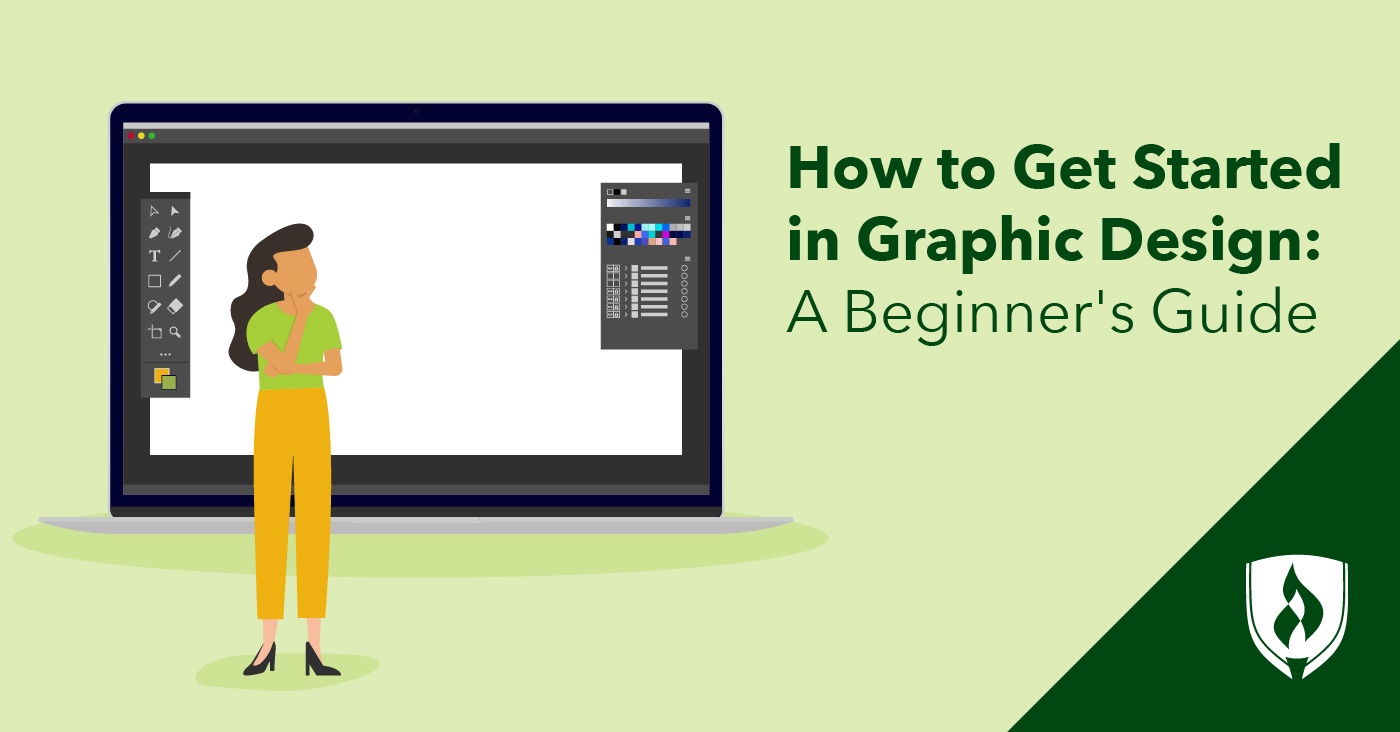
Most of us start our artistic expression by smearing around paint with our fingers and drawing stick figures. Some of us find our talents take us elsewhere while those who still love to dream in visuals—and in the full Pantone® palette—often find themselves wanting a career using their artistic skills every day.
If this sounds like you, you might have already considered a career in graphic design but aren’t quite sure how to take the next step. We talked to professionals in the field to give you a sense of what your educational and experience roadmap might look like. Check out skills needed for graphic design.
How to get started in a graphic design career
“Start designing now—just for fun!” advises Doug Huegel, graphic designer and owner of Doug Does Design. For high school students, Huegel recommends asking people if you could make them a logo or illustration. These early designs might not end up being anything you’ll be particularly proud of years later, but that’s not the point; the practice is key.
“It’s all about trial and error,” Huegel continues. “Dive into every discipline, style and technique. You’ll get tons of practice, build a portfolio in the process and be able to decide where to focus your talents.”
Internships are another way many graphic designers gain experience in the field, though they are more often accessible for those with degrees. If you need to continue working and can’t do an internship that is unpaid or at a lower rate than you can manage, try negotiating.
“If you only have three hours a day to give to an internship, tell them that,” says Libby Schultz, a graphic designer at the Minnesota Department of Transportation. “They might be fine with that and let you keep working.”
Plus, there are other ways to learn more about the job and upskill yourself.
“Immerse yourself in design, talk to people in the industry, always ask questions!” suggests Rebecca Dunthorne, senior designer at Red Sentence™. “Find some groups or clubs and learn about the craft, whether that’s online tutorials or formal study.”
Will I need a degree for a graphic design job?
This is a question that looms large for anyone considering a graphic design career path. While it’s true some self-taught designers can carve out a path for themselves, it can present some substantial challenges. For one, employers generally prefer to know graphic design candidates have a degree; our review of over 40,000 graphic designer job postings found that 74 percent were seeking candidates with a Bachelor’s degree.1
Dunthorne identifies her education as crucial to her own career, choosing to study graphic design for three years after taking an art foundation course.
“I think it’s very important to know the rules and the processes of design to then be able to break them!” Dunthorne explains. “Experience is key for this field, but I do feel you need that education first.”
There are graphic designers who don’t have formal education as there are many things a person can learn on their own if they’re persistent enough.
“I wouldn’t be so bold to say that it would be impossible to be a graphic designer without a formal education,” Huegel says. “But a school’s resources are invaluable because they give you hands-on experience with real-world tools.”
Amy McMahon, graphic designer and owner of Amy Mc Design, found her education to be “invaluable.”
“The projects I got to work on in college gave me a chance to try things out, fail and learn how to improve all while being guided by talented professionals who could push me out of my comfort zone when needed and challenge me to become a better designer.”
What can I do as a Graphic Design student to improve my chances of getting a job?
While formal coursework helps aspiring graphic designers to build a portfolio, Dunthorne emphasizes the need for accumulating experience outside of your classes.
“Learning in the classroom can never fully prepare you for the deadlines of the real world,” Dunthorne explains.
Schultz and Huegel both stress the importance of gaining a general perspective on design across the board, with Huegel emphasizing that graphic designers often evolve in their preferences and style over the years.
“What we enjoy and are good at when we are 22 is very different from when we are 30,” Huegel explains.
Schultz agrees with this, saying that for those generations ahead of her in the field, being siloed into one specialization can have detrimental effects. Take the time to try branching out into different areas of expertise within graphic design, like UX design, web design, print, digital, etc. This gives you a broader base of skills and can help your overall marketability as a designer.
“People will retire, and the rest of their team has no clue to how do what they were doing,” Schultz explains. “Once you’ve tried all kinds of design and being part of different processes, you’ll quickly find what part fits you best.”
Huegel advises that beginning graphic designers keep their focus on their strengths and their initial reasons for wanting to work in this artistic profession.
“Never forget that graphic design is a fun career, so try not to lose sight of enjoying yourself,” Huegel says. “Find what kind of design you really like and stick with it.”
Cultivate a willingness to learn and grow
McMahon believes it’s important for new graphic designers to see the bigger picture and not get too discouraged if you’re having trouble getting established.
“Starting a career is hard, and sometimes it takes a few years to settle into the industry,” McMahon continues. “It is important to focus on listening, working hard and not being afraid to fail.”
Another piece of advice that Huegel believes is crucial for new graphic designers isn’t technical at all but rather based on the perspective you take when talking with potential employers as a new designer.
“Be honest about what you are skill-wise,” Huegel says. “Focus on showing them how open you are to trying new things and taking direction. Your passion and coachability is far more important than your technical skill set.”
No one is a finished product fresh out of college; employers understand you’ll grow and get better as you accumulate experience. Having the right attitude and a demonstrated interest in learning and growing as a designer can go a long way for someone just starting out.
While most potential employers will appreciate a designer with humility and desire to learn, don’t fall into the trap of thinking your beginner’s skill set isn’t valuable.
“Don’t undersell yourself,” Schultz says. “You have more skills than you might give yourself credit for.”
Lay the foundation for a career in graphic design
Getting started is often the hardest part of pursuing a new career field. It takes a determined effort to keep chipping away at the potential barriers to your success. While a formal education might feel like a barrier for some, it should really be thought of as a rock-solid foundation to build the rest of your career upon.
1Burning-Glass.com (analysis of 41,955 graphic designer job postings, from July 1, 2020 – June 30, 2021)
Pantone is a registered trademark of Pantone, Inc.




